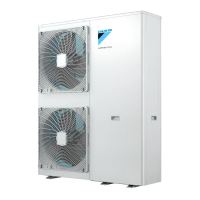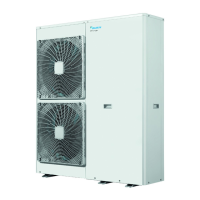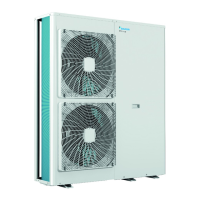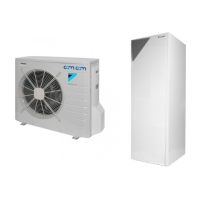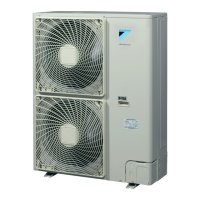5 Application guidelines
Installer reference guide
23
EBLQ+EDLQ011~016CAV3+W1 + EK(2)CB07CAV3 +
EKMBUHCA3V3+9W1
Daikin Altherma low temperature monobloc
4P522034-1 – 2018.01
Example
Single-phase power meter Three-phase power meter
b
5
8
0
1
5
0
0
0
c c
ed
f
A B C D E
a
g h
A Outdoor unit
B Control box
C DHW tank
D Option box
E Backup heater kit
a Electrical cabinet (L
1
/N)
b Power meter (L
1
/N)
c Fuse (L
1
/N)
d Outdoor unit (L
1
/N)
e Control box (L
1
/N)
f Booster heater (L
1
/N)
g Option box (L
1
/N)
h Backup heater (L
1
/N)
b
5
8
0
1
5
0
0
0
fe
i
A B E
c c d
a
g
C
h
D
A Outdoor unit
B Control box
C DHW tank
D Option box
E Backup heater kit
a Electrical cabinet (L
1
/L
2
/L
3
/N)
b Power meter (L
1
/L
2
/L
3
/N)
c Fuse (L
1
/N)
d Fuse (L
1
/L
2
/L
3
/N)
e Outdoor unit (L
1
/N)
f Control box (L
1
/N)
g Booster heater (L
1
/N)
h Option box (L
1
/N)
i Backup heater (L
1
/L
2
/L
3
/N)
Exception
▪ You can use a second power meter if:
▪ The power range of one meter is insufficient.
▪ The electrical meter cannot easily be installed in the electrical
cabinet.
▪ 230 V and 400 V three-phase grids are combined (very
uncommon), because of technical limitations of power meters.
▪ Connection and setup:
▪ Connect the second power meter to X2M/9 and X2M/10 of
option box EK2CB07CAV3.
▪ In the software the power consumption data of both meters is
added so you do NOT have to set which meter covers which
power consumption. You only need to set the number of pulses
of each power meter.
▪ See "5.5.4 Preferential kWh rate power supply" on page 23 for
an example with two power meters.
5.5.4 Preferential kWh rate power supply
General rule
▪ Power meter1: Measures the refrigerant part of the outdoor unit.
▪ Power meter 2: Measures the rest (i.e. the hydro part of the
outdoor unit, control box EKCB07CAV3, option box
EK2CB07CAV3, the backup heater kit, and the optional booster
heater).
Setup
▪ Connect power meter 1 to X2M/7 and X2M/8 of option box
EK2CB07CAV3.
▪ Connect power meter 2 to X2M/9 and X2M/10 of option box
EK2CB07CAV3.
Power meter types
▪ Power meter1: Single-phase power meter.
▪ Power meter2:
▪ In case of a single-phase backup heater configuration, use a
single-phase power meter.
▪ In other cases, use a three-phase power meter.
Example
Three-phase backup heater:
e fe
hg
k
A E
ba
d
i
CB
j
D
c
5
8
0
1
5
0
0
0
5
8
0
1
5
0
0
0
A Outdoor unit
B Control box
C Domestic hot water tank
D Option box
E Backup heater kit
a Electrical cabinet (L
1
/N): Preferential kWh rate power
supply
b Electrical cabinet (L
1
/L
2
/L
3
/N): Normal kWh rate power
supply
c Power meter (L
1
/N)
d Power meter (L
1
/L
2
/L
3
/N)
e Fuse (L
1
/N)
f Fuse (L
1
/L
2
/L
3
/N)
g Outdoor unit (L
1
/N)
h Control box (L
1
/N)
i Booster heater (L
1
/N)
j Option box (L
1
/N)
k Backup heater (L
1
/L
2
/L
3
/N)
5.6 Setting up an external temperature
sensor
You can connect one external temperature sensor. It can measure
the indoor or outdoor ambient temperature. Daikin recommends to
use an external temperature sensor in the following cases:
Indoor ambient temperature
▪ In room thermostat control, the user interface is used as room
thermostat and it measures the indoor ambient temperature.
Therefore, the user interface must be installed on a location:
▪ Where the average temperature in the room can be detected
▪ That is NOT exposed to direct sunlight
▪ That is NOT near a heat source
▪ That is NOT affected by outside air or air draught because of,
for example, door opening/closing
▪ If this is NOT possible, Daikin recommends to connect a remote
indoor sensor (option KRCS01-1).
▪ Setup:
▪ Requires control box EKCB07CAV3 and option box
EK2CB07CAV3.
▪ For installation instructions, see the installation manual of the
remote indoor sensor and the addendum book for optional
equipment.
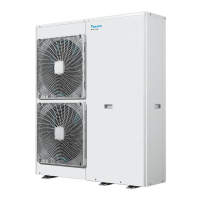
